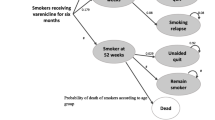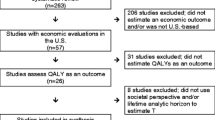Summary
There is a paucity of studies on the economics of smoking cessation. Those undertaken have investigated only a narrow range of available interventions, using variable methodologies which make interstudy comparisons problematical. There is a need for more economic appraisal in this area and for greater consistency in the methodologies employed. Growing evidence on the effectiveness of pharmacotherapies has not been matched by evidence of their cost effectiveness, and studies in this area, particularly on transdermal nicotine, are urgently required.
Cost-benefit analyses (CBAs) have focused on programmes targeted at pregnant women and indicate that resource savings, mainly from reductions in the number of low birthweight neonates, can exceed the costs of the measures. Efforts to persuade pregnant women to quit thus appear to be highly cost beneficial, but further evidence on the efficiency of measures targeted at other groups or to the general population of smokers is required.
Cost-effectiveness analyses (CEAs) suggest that measures targeted at specific groups are more cost effective than those targeted at the general population of smokers, and that the cost effectiveness of such programmes is further improved by providing educational materials that are specific to the targeted groups. Advice on how to maintain abstinence appears to improve the cost effectiveness of help with quitting, and routine advice from physicians to their smoking patients is a cost-effective way of reducing smoking prevalence.
Similar content being viewed by others
References
Atkinson A, Townsend J. Economic aspects of reduced smoking. Lancet 2: 492–495, 1977
Altman DG, Flora JA, Fortmann SP, Farquhar JW. The cosl-effectiveness of three smoking cessation programs. American Journal of Public Health 77: 162–165, 1987
Chapman S. Changes in adult cigarette consumption in 128 countries, 1986–90. Tobacco Control 1(4): 281–284, 1992
Coyle D, Tolley K. Discounting of health benefits in the pharmacoceconomic analysis of drug therapies: an issue for debate? PharmacoEconomics 2: 153–162, 1992
Cox JL, McKenna JP. Nicotine gum: does providing it free in a smoking cessation program alter success rates? Journal of Family Practice 31(3): 278–280, 1990
Cummings SR, Rubin SM, Oster G. The cost-effectiveness of counseling smokers to quit. Journal of the American Medical Association 261: 75–79, 1989
Danaher BG, Berkanovic E, Gerber B. Mass media based health behavior change televised smoking cessation programme. Addictive Behaviors 9: 243–253, 1984
Davis AL, Faust R, Ordentlich M. Self-help smoking cessation and maintenance programs: a comparative study with 12-month follow-up by the American Lung Association. American Journal of Public Health 74(11): 1212–1217, 1984
Doll R. Smoking: the past 40 years and the next 40: twice the killer we thought. Edited version of a talk the Royal Society, 5 February, 1993 Health Supplement, London, March 1993
Doll R, Gray R, Haffener B, Peto R. Mortality in relation to smoking: 22 years observation of female British doctors. British Medical Journal 301: 1343–1344, 1990
Drummond MF. Principles of economic appraisal in health care, Oxford University Press, Oxford, 1980
Drummnond MF, Stoddart GL, Torrance GW. Methods for the economic evaluation of health care programmes, Oxford University Press, Oxford, 1987
Elixhauser A. The costs of smoking and the cost effectiveness of smoking-cessation programs. Journal of Public Health Policy, Summer: 218–235, 1990
Erfurt JC, Foote A, Heirich MA. The cost-effectiveness of work-site wellness programs for hypertension control, weight loss, and smoking cessation. Journal of Occupational Medicine 33: 962–970, 1991
Ershoff DH, Quinn VP, Mullen PD, Lairson DR. Pregnancy and medical cost outcomes of a self-help prenatal smoking cessation program in a HMO. Public Health Reports 105(4): 340–347, 1990
Fagerstrom KO. Measuring degree of physical dependence to tobacco smoking with reference to individualised treatment. Addictive Behaviours 3: 235–241, 1978
Herben JR, Kristeller J, Ockene JK, Landon J, Luippold R, et al. Patient characteristics and the effect of the three physician-delivered smoking interventions. Preventive Medicine 21(5): 557–573, 1992
Hjalmarson AI. Effect of nicotine chewing gum in smoking cessation: a randomised placebo controlled double blind study. Journal of the Americal Medical, Society 252: 2835–2838, 1984
Hodgson TA. Cigarette smoking and lifetime medical expenditures. Milbank Quarterly 70: 81–117, 1992
Hughes J, Gust S, Keenan R, Fenwick J, Healey M. Nicotine versus placebo gum in general practice. Journal of the American Medical Society 266: 3133–3138, 1989
Imperial Cancer Research Fund General Practicc Research Group. Effectiveness of nicotine patch in helping people to stop smoking: results of a randomised trial in general practice. British Medical Journal. 306: 1304–1308, 1993
Jamrozik K, Fowler G. Anti-smoking education in Oxfordshire general practices. Journal of the Royal College of General Practitioners. 32: 179–183, 1982
Jamrozik K, Vessey M, Fowler C, Wald N, Parker G, et al. Controlled trial of three different antismoking interventions in general practice. British Medical Journal 288: 1499–1502, 1984
Kottke T. Battista R, De Brise G, Brekka M. Attributes of successful smoking cessation interventions in medical practice: a meta-analysis of 39 controlled trials. Journal of the American Medical Association 259: 2883–2889, 1988
Lam W, Sze PC, Sacks HS, Chalmers TC. Meta-analysis of randomised controlled trials of nicotine chewing-gum. Lancet 2(8549): 27–30, 1987
Leu RE, Schaub T. Does smoking increase medical care expenditure? Social Science and Medicine 17: 1907–1914, 1983
Leu RE, Schaub T. More on the impact of smoking on medical care expenditures. Social Science and Medicine 21: 825–827, 1985
Manning WE, Keeler EB. Newhouse JP. Sloss EM, Wasserman J. The taxes of sin: do smokers and drinkers pay their way? Journal of the American Medical Association 261: 1604–1609, 1989
Marks JS, Koplan JP. Hogue CJR, Dalmat ME. A cost-benefit/cost-effectiveness analysis of smoking cessation for pregnant women. American Journal of Preventive. Medicine 6(5): 282–289, 1990
Maynard A. Developing a health care market. Economic Journal 101: 1277–1286, 1991
McParlane EC, Mullen PD, DeNino LA. The cost effettiveness of an education outreach representative to OB practitioners to pro-mote smoking cessation counseling. Patient Education and Counseling 9: 263–274, 1987
Oster G, Huse DM, Delea TE, Colditi GA. Cost-effectiveness of nicotine gum as an adjunct to physician’s advice against cigarette smoking. Journal of the American Medical Association 256: 1315–1318, 1986
Owen N, Davies MJ. Smokers preferences for assistance with cessation. Preventive Medicine 19: 424–431, 1990
Phillips D, Kawachi I, Tilyard M. The economics of smoking: an overview of the international and New Zealand literature. PharmacoEconomics 3: 462–470, 1993
Phillips D, Kawachi I, Tilyard M. The costs of smoking revisited. New Zealand Medical Journal 105: 240–243, 1992
Russell M, Wilson C, Taylor C, Baker C. Effect of general practitioners’ advice against smoking. British Medical Journal 2: 231–235, 1979
Russell MAH. Targeting heavy smokers in general practice: randomised controlled trial of transdermal nicotine patches. British Medical Journal 306: 1308–1312, 1993
Sanders D. Effective health promotion — giving up smoking: the evidence of how health professionals can help, Health Education Authority, London, 1992
Shipp M, Croughan-Minihane MS, Petitti DB, Washington AE. Estimation of the break-even point for smoking cessation programs in pregnancy. American Journal of Public Health 82(3): 383–390, 1992
Sutherland G, Stapleton JA, Russell MAH, Jarvis MJ, Belcher M, et al. Randomised control trial of nasal nicotine spray in smoking cessation. Lancet 340: 324–329, 1992
Tonnesen P, Norregaard J, Simonsen K, Sawe U. A double-blind trial of 16 hour transdermal nicotine patch in smoking cessation. New England Journal of Medicine; 325: 311–315, 1991
Tonnesen P, Norregaard J, Mikkelson K, Jorgensen S, Nilsson F. A double-blind trial of a nicotine inhaler for smoking cessation. Journal of the Americal Medical Asociation 269(10): 1268–1271, 1993
Tsevat J. Impact and cost-effectivenes of smoking interventions. American Journal of Medicine 93(Suppl. 1A): 43–47, 1992
US Public Health Service. The health consequences of smoking: nicotine addition. Report of the Surgeon General, US Department of Health and Human Services, Washington, 1988
Warner KE. Selling smoke: cigarette advertising and public health, American Public Health Association, Washington, 1986
Weiss SJ, Jurs S, Lesage JP, Iverson DC. A cost-benefit analysis of a smoking cessation program. Evaluation and Program Planning 7: 337–346, 1984
Williams A. Screening for risk of CHD: is it a wise use of resources? In Oliver et al (Eds) Screening for risk of coronary heart disease, pp. 97–106, John Wiley and Sons, Chichester, 1987
Windsor RA, Lowe JB, Perkins LL, Smith-Yoder D, Artz L, et al. Health education for pregnant smokers: its behavioural impact and cost benefit. American journal of Public Healdi 83(2): 201–206, 1993
Windsor RA, Warner KE, Cutter GR. A cost-eftectiveness analysis of self-help smoking cessation methods for pregnant women. Public Health Reports 103: 83–88, 1988
Author information
Authors and Affiliations
Rights and permissions
About this article
Cite this article
Cohen, D.R., Fowler, G.H. Economic Implications of Smoking Cessation Therapies. PharmacoEconomics 4, 331–344 (1993). https://doi.org/10.2165/00019053-199304050-00004
Published:
Issue Date:
DOI: https://doi.org/10.2165/00019053-199304050-00004




